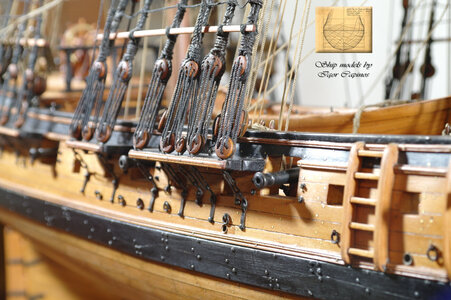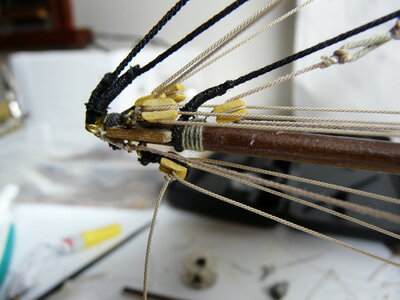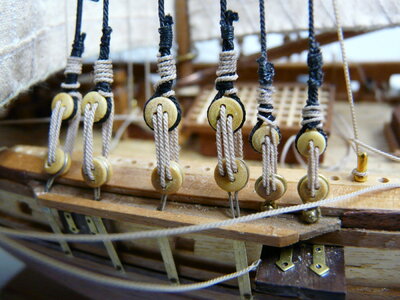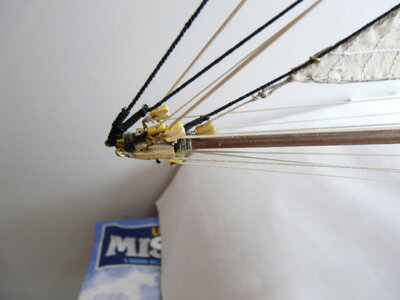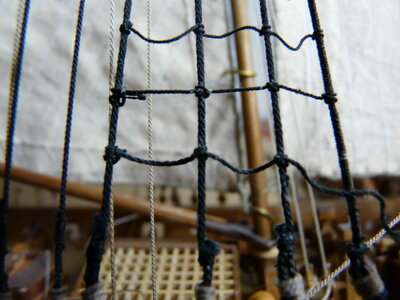I'd like to get some feedback about what people think about polyester rigging thread. I realize it has both pros and cons. I'm working on a Mamoli Victory and it came with virtually no thread at all. Especially no black for standing rigging. So, I bought some .5mm black cotton prewaxed which seems to work well. Over the years, accumulated quite a bit of black poly. What I have came on both rolls and flat wrapped and seems to hold the shape of what it was spooled on. I actually tried running it through a flame to remove curls and kinks. That works pretty good, also managed to stretch it a little with no expected shrinkage. Thanks, Ken
You are using an out of date browser. It may not display this or other websites correctly.
You should upgrade or use an alternative browser.
You should upgrade or use an alternative browser.
Just FYI. Dolmanoff the maker of very good rope making machines for models recommends polyester threads only.
I am not an expert on rigging lines, however, I can only add to this ----In short, I hate nylon or polyester thread. When or if the company sends the line on those flat plastic holders, then the line retains its shape and as you unwind the line off the flat plastic holder, it is zig zaggy. The only way I have found to work with this stuff is to use a mixture of 50/50 white glue and water on the line - as I have tied the line to a door top or something and put a weight on end to straighten the line out. The slight mixture also makes the line a little stiff which is good for me.
The cotton line to me is the best and is more authentic and is best to always use real beeswax and run the line several times through that to eliminate the fuzziness. Some companies specialize in rigging line and are much better quality and do not need beeswax probably because the line is made on a rope machine device and produces a higher quality line that will have almost nearly no fuzzy to it. Just my opinion..
When I built my Mantua/ Panart San Felipe, they did not supply nearly enough rigging line to "seize or serve" anything. I had to buy if I remember about 15 each rolls of .15 or .20 to complete the rigging. That size was used to serve the ends and wrap the lines that go around the Shroud Pairs and other things.
The cotton line to me is the best and is more authentic and is best to always use real beeswax and run the line several times through that to eliminate the fuzziness. Some companies specialize in rigging line and are much better quality and do not need beeswax probably because the line is made on a rope machine device and produces a higher quality line that will have almost nearly no fuzzy to it. Just my opinion..
When I built my Mantua/ Panart San Felipe, they did not supply nearly enough rigging line to "seize or serve" anything. I had to buy if I remember about 15 each rolls of .15 or .20 to complete the rigging. That size was used to serve the ends and wrap the lines that go around the Shroud Pairs and other things.
I have never made rope with polyester rope until this point so I thought that this was as good as a time as any good to experiment:
![IMG_3950[1].JPG IMG_3950[1].JPG](https://shipsofscale.com/sosforums/data/attachments/192/192033-fa3e5f6a054ba66fd0ac52bfcf927a0c.jpg)
Using Gutermann thread and the Domanoff rope walk I made these two samples. For both I used six strands of thread and they measure .6 mm in diameter, the one on the left is the 100% cotton and the other is 100% polyester.
![IMG_3951[1].JPG IMG_3951[1].JPG](https://shipsofscale.com/sosforums/data/attachments/192/192035-7972b5c1947fa118cc896769a36e36f3.jpg)
This is a super macro, on the cotton rope(left) you can see a little fuzz while the polyester is pretty much bare, the fuzz is not noticeable with the naked eye. They both seem to handle the same as far as flexibility and texture are concerned. It seems in this minor test the polyester one is just as good if not better than the cotton, I would not be scared to use polyester after seeing these results.
![IMG_3952[1].JPG IMG_3952[1].JPG](https://shipsofscale.com/sosforums/data/attachments/192/192037-5791f321a03efdadc2bc30ff957c583a.jpg)
Here is the thread I used
![IMG_3950[1].JPG IMG_3950[1].JPG](https://shipsofscale.com/sosforums/data/attachments/192/192033-fa3e5f6a054ba66fd0ac52bfcf927a0c.jpg)
Using Gutermann thread and the Domanoff rope walk I made these two samples. For both I used six strands of thread and they measure .6 mm in diameter, the one on the left is the 100% cotton and the other is 100% polyester.
![IMG_3951[1].JPG IMG_3951[1].JPG](https://shipsofscale.com/sosforums/data/attachments/192/192035-7972b5c1947fa118cc896769a36e36f3.jpg)
This is a super macro, on the cotton rope(left) you can see a little fuzz while the polyester is pretty much bare, the fuzz is not noticeable with the naked eye. They both seem to handle the same as far as flexibility and texture are concerned. It seems in this minor test the polyester one is just as good if not better than the cotton, I would not be scared to use polyester after seeing these results.
![IMG_3952[1].JPG IMG_3952[1].JPG](https://shipsofscale.com/sosforums/data/attachments/192/192037-5791f321a03efdadc2bc30ff957c583a.jpg)
Here is the thread I used
Those flat plastic holders are terrible. I run the thread through a flame real quick and that gets rid of the "zig-zag" problem. Keep the line taut while running through flame.I am not an expert on rigging lines, however, I can only add to this ----In short, I hate nylon or polyester thread. When or if the company sends the line on those flat plastic holders, then the line retains its shape and as you unwind the line off the flat plastic holder, it is zig zaggy. The only way I have found to work with this stuff is to use a mixture of 50/50 white glue and water on the line - as I have tied the line to a door top or something and put a weight on end to straighten the line out. The slight mixture also makes the line a little stiff which is good for me.
The cotton line to me is the best and is more authentic and is best to always use real beeswax and run the line several times through that to eliminate the fuzziness. Some companies specialize in rigging line and are much better quality and do not need beeswax probably because the line is made on a rope machine device and produces a higher quality line that will have almost nearly no fuzzy to it. Just my opinion..
When I built my Mantua/ Panart San Felipe, they did not supply nearly enough rigging line to "seize or serve" anything. I had to buy if I remember about 15 each rolls of .15 or .20 to complete the rigging. That size was used to serve the ends and wrap the lines that go around the Shroud Pairs and other things.
just started using polyester rigging line and i have to say i much prefer it over the the cotton line supplied by most kit makers. for one thing absolutely no line fuzz that has to be burnt off, sometimes with disastrous results. the twist of the line especially on the .45 mil and up looks amazing and the color is very realistic ( in the tan ). the other thing is that the polyester line has a fair bit of stretch so that when you need a taut line look you can with only slight tension get that look without putting stress on points that could be distorted or pulled out of alignment with regular line. the only drawbacks are- #1 price . for large models it may be cost prohibitive .
#2 line MUST be ca'ed before cutting or it will unravel. i would not use it for small scale models, but for 1:48 and down the difference will take your build to the next level.
#2 line MUST be ca'ed before cutting or it will unravel. i would not use it for small scale models, but for 1:48 and down the difference will take your build to the next level.
Last edited:
The Russian master model builders use polyester rigging line. Their models are the best in the world.
Their models are the ONE of the best in the world.Their models are the best in the world.
Yes of course Jim. You are correct. Just look at Andrey Kudin of Israel's model.
Открою вам большой секрет. Вам не нужно покупать Guteman. Можно использовать полиэстер Юго-Восточной Азии. После скручивания быстро протяните веревку через пламя газовой горелки. Ворс удаляется, внутренние напряжения снимаются, и получается веревка высшего качества. Вы можете протянуть веревку через расплавленный воск и протереть сухой хлопчатобумажной тканью, чтобы полностью имитировать корабельную веревку.
Translate by Jim
I'll tell you a secret. You don't have to buy Guteman thread. You can use a Southeast Asian polyester. After twisting, quickly stretch the rope through the flames of the cigarettes' lighter flame. The fuzz is removed, the internal tensions are removed, and the rope is obtained of the highest quality. You can stretch the rope through the molten wax and rub with dry cotton cloth to fully mimic the ship's rope.
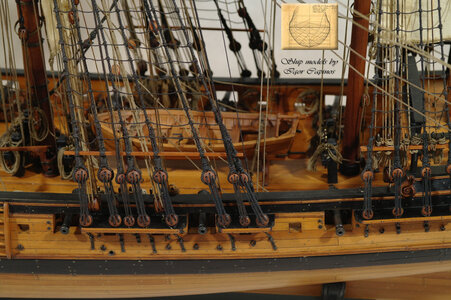
Translate by Jim
I'll tell you a secret. You don't have to buy Guteman thread. You can use a Southeast Asian polyester. After twisting, quickly stretch the rope through the flames of the cigarettes' lighter flame. The fuzz is removed, the internal tensions are removed, and the rope is obtained of the highest quality. You can stretch the rope through the molten wax and rub with dry cotton cloth to fully mimic the ship's rope.

so,,, in reference to a rope walk... does the twist bind the thread together? All these look so much better than the average rigging "string" that I have been using for years. to make a .25 diameter twist according sizes... .o6 etc... The stuff I've been using for years is just basically garbage... plus,, cotton or polyester/nylon? thank you,,, Ken
I don't think I will ever be a master/professional builder, but after doing this for the last 15 years, I would like to make mine look at professional as possible. I'm on my eighth build and still learningso,,, in reference to a rope walk... does the twist bind the thread together? All these look so much better than the average rigging "string" that I have been using for years. to make a .25 diameter twist according sizes... .o6 etc... The stuff I've been using for years is just basically garbage... plus,, cotton or polyester/nylon? thank you,,, Ken
- Joined
- Aug 8, 2019
- Messages
- 4,110
- Points
- 688

I'm using Serafill to, and I'm very happy with it. The strings are 120/2 that means 0,12 mm very thin. Made rope up to 2 mm and used for that 96 strings. Al the ropes I had made look like this:
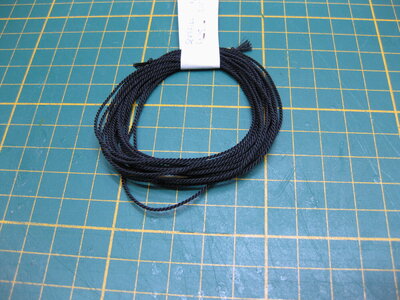
A cone 5000 meters of string, polyester and very strong.
3 strings give you a rope of 0,22 mm
And I went up to 3x32 (96) strings to get rope that had a diameter of 2 mm
And no FUZZ

A cone 5000 meters of string, polyester and very strong.
3 strings give you a rope of 0,22 mm
And I went up to 3x32 (96) strings to get rope that had a diameter of 2 mm
And no FUZZ
Last edited:
The thing is ,,, the models 1/90 virtually never have 2 mm... excecpt for main stays...even then ,, that's large.
@ken s Hello, Ken. Not everyone has the ability to made their own ropes for different reasons, Today, the market has many merchants making a scale rope for modelers. In some of the Russian on-line stores, the store in Germany has excellent (true to the scale) rigging lines. But for us in the USA, we have a great store across the border @craftysailor. Egor recently acquired rigging lines from Russia, please check them out

 craftysailor.com
craftysailor.com

Ropes & Materials
Handmade ropes for model ship kits. Made from Gutermann polyester monofilament thread.
 craftysailor.com
craftysailor.com
- Joined
- Aug 8, 2019
- Messages
- 4,110
- Points
- 688

And the builders in Europe look at here:
 www.rigging-ropes.com
www.rigging-ropes.com
Rigging Ropes for Modelers – produced in own ropery
 www.rigging-ropes.com
www.rigging-ropes.com
This is exactly the German site I was talking about... Many Thanks!And the builders in Europe look at here:




